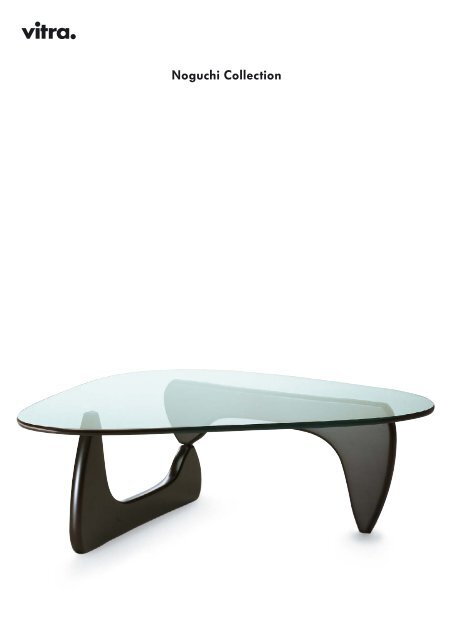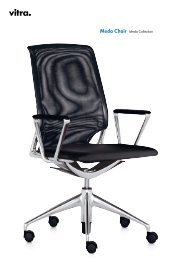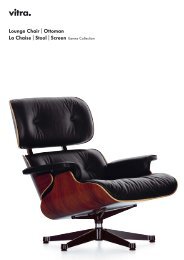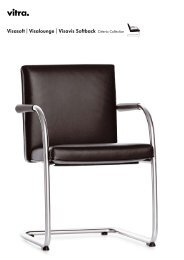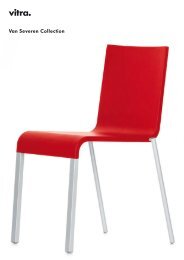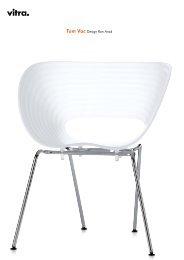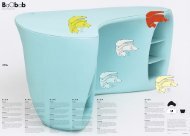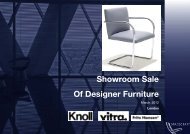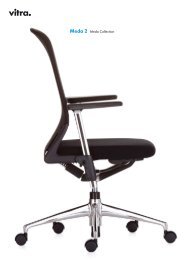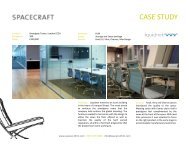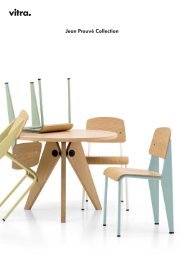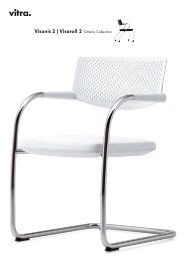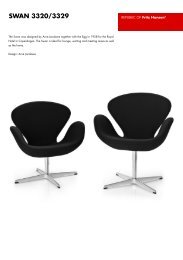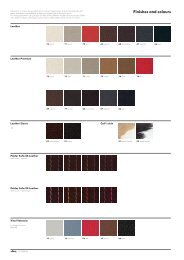Noguchi Collection - Designcollectors.com
Noguchi Collection - Designcollectors.com
Noguchi Collection - Designcollectors.com
Create successful ePaper yourself
Turn your PDF publications into a flip-book with our unique Google optimized e-Paper software.
<strong>Noguchi</strong> <strong>Collection</strong>
Cylinder Lamp 1944<br />
The work of the Japanese-American artist and designer<br />
Isamu <strong>Noguchi</strong> is extraordinarily multi-faceted. In<br />
addition to sculptures, he also created stage sets,<br />
furniture, lighting, interiors, public spaces and gardens.<br />
As a sculptor, he was not only interested in materials<br />
and forms, but also in the spatial effect of objects and<br />
even in the design of space itself. It was his intention<br />
to create artworks with practical and social relevance.<br />
<strong>Noguchi</strong>'s work left a lasting mark on 1950s design.<br />
Prismatic Table 1957<br />
Since 2002, the Vitra Design Museum has produced reeditions<br />
of <strong>Noguchi</strong>'s designs in co-operation with the<br />
Isamu <strong>Noguchi</strong> Foundation, New York. Several of these<br />
models are represented in the <strong>Collection</strong> of the Vitra<br />
Design Museum.<br />
Tea Cup 1952<br />
Knife, Fork & Spoon 1952<br />
Coffee Table 1944<br />
Freeform Sofa 1946<br />
Rocking Stools 1954
Cylinder Lamp<br />
The three-legged Cylinder Lamp with its<br />
lampshade made of transparent plastic<br />
and organically shaped wooden legs is<br />
one of Isamu <strong>Noguchi</strong>’s first lighting<br />
designs. Originally made as a present<br />
for his sister, the luminaire went into<br />
serial production in 1945 and became<br />
a trendsetting and often-copied success.<br />
Prismatic Table<br />
The small Prismatic Table was <strong>Noguchi</strong>'s first furniture<br />
design intended for serial production. Made of bent<br />
aluminium sheeting, it was created for Alcoa (Aluminum<br />
Company of America), who wanted to demonstrate<br />
new applications of its primary product. <strong>Noguchi</strong>’s own<br />
motivation for this design can be traced to his previous<br />
experimentation with sheet metal (particularly brass<br />
sheeting), which began during his work with Brancusi<br />
in Paris.
Tea Cup | Knife, Fork & Spoon<br />
Although Tea Cup reveals the formal language of modern design,<br />
it is actually based on an ancient Japanese terracotta cup that was<br />
in <strong>Noguchi</strong>’s possession. With this tea cup and saucer <strong>Noguchi</strong><br />
succeeded in creating a sculptural object that in a unique manner<br />
blended western Modernism with the traditional Japanese tea<br />
ceremony. The fork, knife, and tea spoon, which presumably were<br />
created around the same time, demonstrate how Isamu <strong>Noguchi</strong><br />
should be seen rather as a sculptor than a designer.<br />
Coffee Table<br />
<strong>Noguchi</strong> designed the first version of this table, with a glass top resting<br />
on interconnected rosewood supports, for the private residence of MoMA<br />
president A. Conger Goodyear during the 1930s. In a modified design<br />
from 1944, which reflected his preoccupation with sculptural, biomorphic<br />
structures, <strong>Noguchi</strong> transformed the original idea into a base consisting<br />
of two identical wooden elements, one of which is reversed and pinned<br />
to the other at a right angle. The Coffee Table has been produced for the<br />
US market by Herman Miller since 1947; the Vitra Design Museum began<br />
production for the European market in 2002. It is regarded today as one<br />
of <strong>Noguchi</strong>’s best-known designs.<br />
Table top with etched signature, rounded edges.
Freeform Sofa<br />
<strong>Noguchi</strong>’s sculptural idiom gains full expression in this sofa, which clearly<br />
distinguishes itself from other designs of the same period. The sofa and<br />
ottoman seem almost like a greatly enlarged sculpture of flat, rounded<br />
river stones; yet at the same time, their slender organic forms are graceful<br />
and vigorous. <strong>Noguchi</strong> emphasised this effect with thin, but extremely<br />
<strong>com</strong>fortable upholstery padding and a choice of cover fabrics in natural<br />
colours.<br />
The Freeform Sofa and <strong>com</strong>panion Ottoman were produced around 1950<br />
in limited number. Today, the few remaining pieces achieve record prices<br />
at auction. Since 2002, the group has been produced by the Vitra Design<br />
Museum as a fully authentic re-edition. The sofa is suitable not only for<br />
use in the living room, but also in lobbies, hotels and retail shops.
Programme features<br />
All measurements in millimetres and inches<br />
Freeform Sofa and Ottoman<br />
Re-edition Vitra Design Museum. Solid wood frame,<br />
upholstered. Removable cover in Soft fabric. Legs are<br />
available optionally in maple, natural finish or walnut<br />
stain, depending on colour of upholstery fabric.<br />
Coffee Table<br />
Vitra Design Museum re-edition. Frame of solid black<br />
ash, walnut or maple. Table top made of 19 mm thick<br />
glass with etched signature, rounded edges.<br />
Prismatic Table<br />
Re-edition Vitra Design Museum. Aluminium corpus,<br />
powder-coated finish in black or white. Also suitable<br />
for outdoor use.<br />
Freeform Sofa<br />
720 28 1 /4” 1300 51 1 /4”<br />
3000 118” 1200 47 1 /4”<br />
710 28”<br />
380 15”<br />
Rocking Stool<br />
Re-edition Vitra Design Museum. Stool in two sizes.<br />
Slightly rounded seat and base elements made of<br />
maple, natural colour or walnut stain. Connecting<br />
element with diagonal struts made of chrome-plated<br />
steel rod.<br />
Soft<br />
Maple<br />
Maple stained<br />
walnut-colour<br />
Tea Cup<br />
Ceramic<br />
Knife, Fork & Spoon<br />
Highly polished stainless steel.<br />
Cylinder Lamp<br />
Plastic, maple legs, stained cherry-colour.<br />
930 36 1 /2”<br />
Black ash Walnut Maple<br />
1280 50 1 /2”<br />
400 15 3 /4”<br />
Coffee Table<br />
410 16 1 /4”<br />
375 14 3 /4”<br />
Prismatic Table<br />
Maple<br />
Maple stained<br />
walnut-colour<br />
Ø 360 Ø14 1 /4” Ø 360 Ø14 1 /4”<br />
425 16 3 /4”<br />
Rocking Stool<br />
250 9 3 /4”<br />
Deviations in colour are<br />
possible due to the printing<br />
process.<br />
400 15 3 /4”<br />
Ø180 Ø7”<br />
Cylinder Lamp
Rocking Stool<br />
During his entire lifetime, <strong>Noguchi</strong> alternated between<br />
East and West. After returning from Japan in 1954, he<br />
presented the design for a Rocking Stool to US furniture<br />
manufacturer Hans Knoll. Its form evokes the hourglass<br />
shape of African stools. Although <strong>Noguchi</strong> originally<br />
wanted to make the stool out of polyurethane, a new<br />
plastic, he ultimately decided on a <strong>com</strong>bination of more<br />
traditional materials: wood for the seat and foot, and<br />
chrome-plated steel rods for the central support.
Vitra International AG, Birsfelden, CH | Vitra Ges.m.b.H., Wien, A | NV Vitra Belgium SA, Diegem, B | Vitra AG, Birsfelden, Showroom: Zürich, CH | Vitra koncept, s.r.o., Praha, CZ | Vitra GmbH, Weil am Rhein, Showroom: Frankfurt, D | Vitra<br />
Hispania S.A., Madrid, Showroom: Barcelona, E, Lisboa, P | Vitra, Paris, F | Vitra Ltd., London, GB | Vitra International AG, Budapest, HU | Vitra International AG, Mumbai/Bangalore/New Delhi, IN | Vitra (Nederland) B.V., Ouderkerk aan de Amstel, NL<br />
Vitra Scandinavia AS, Oslo, N | Vitra International AG, Warszawa, PL | Vitra Furniture (Shanghai) Co., Ltd., Shanghai, PRC | Vitra Furniture Pte. Ltd., Singapore | Vitra Inc., New York, Culver City, San Francisco, Chicago, USA | info@vitra.<strong>com</strong> | www.vitra.<strong>com</strong><br />
2008, Art.-Nr. 097 312 20<br />
® All intellectual property rights, such as trademarks, patents and copyrights are reserved. Nothing shown on this printed matter may be reproduced without written permission.


